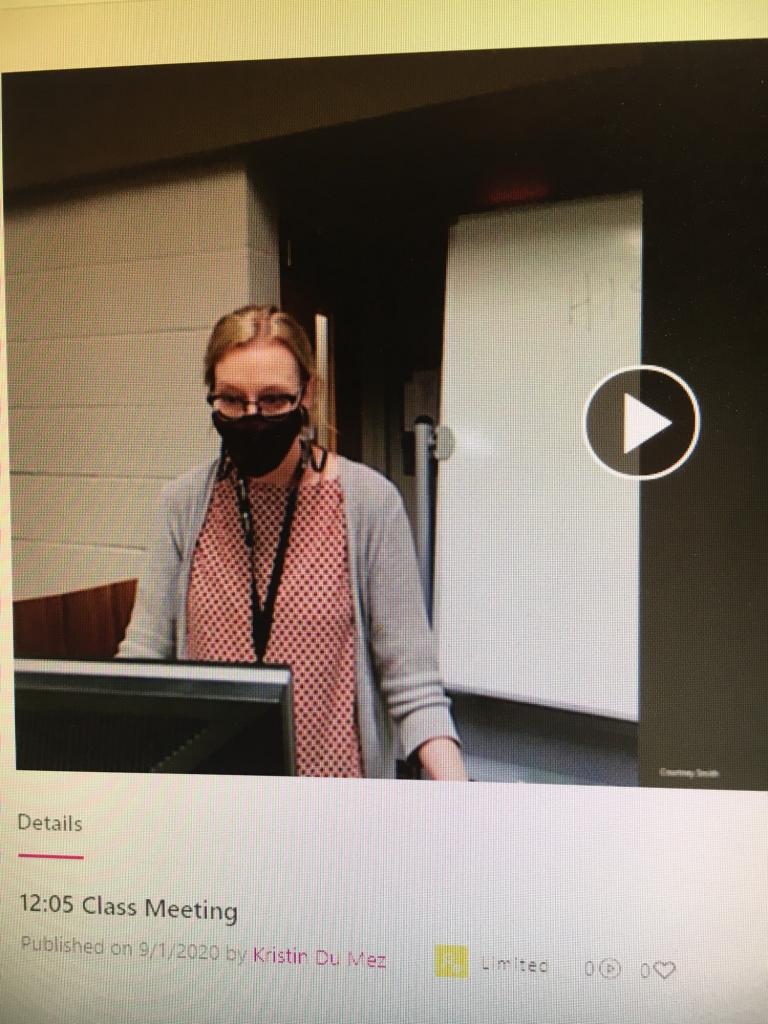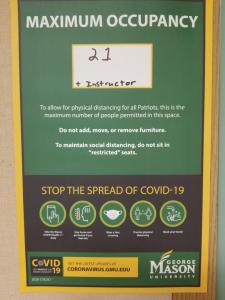In the midst of a pandemic that has claimed a million lives worldwide (over 200,000 of them here in the United States), thousands of American colleges and universities have started another academic year. Some are entirely online, but most are pursuing some kind of hybrid or blended arrangement, hoping to limit the spread of COVID-19 even as students and employees gather on campus. (Here’s a database showing the variety of strategies.)
So what’s it like to teach in the midst of this unique season in American higher education? I gave a two-week update of my own in mid-September, but I was curious to hear from my colleagues here at Anxious Bench. So I’m happy to share reports from four of our contributors. Together, they represent a mix of universities: large and small, public and private, different parts of the country, using remote and hybrid education to varying degrees. (Chris Gehrz)
Asbury University
Wilmore, Kentucky – about 2,000 students total
Like many small liberal arts institutions that could be ruined financially if they went fully remote, Asbury is using a Hy-Flex format for instruction this year. Students can attend sessions live in the classroom, live on Zoom, or watch a recording at another time as needed. If students attend in person, they are masked and spaced six feet apart. There are cleaning supplies in each classroom, though few students appear to use them. There are plexiglass barriers, though few faculty appear to use them. I typically find the barriers pushed against the wall when I arrive in a room.

I’m teaching four classes this semester: two sections of Western Civ. II, a senior history capstone course, and a first-year liberal arts seminar. My 11 a.m. MWF Western Civilizations II course has thirty students. The room only fits twenty-five students, so at the beginning of the semester I split the class into three groups. On Mondays, Groups 1 and 2 attend in person, and Group 3 attends remotely via Zoom. On Wednesdays, Groups 2 and 3 attend in person, and Group 1 attends remotely. On Fridays, Groups 3 and 1 attend in person, and Group 2 attends remotely. I also have one student who Zooms in from Rwanda, where it is 5 p.m. when the class meets. Another student lives in Korea, where it is midnight. He watches a recording of the class session on his own time.
It’s going ok . . . I think. It’s very difficult to read students’ reactions, and I feel like I’m not connecting with students as well as usual. I’m pinned to the lectern in order to stay in range of my laptop’s camera. Even so, my remote students still can’t see or hear what’s happening in classroom discussions. So I try to repeat what is being said. The complexity of simultaneously facilitating chat rooms and in-seat conversations, combined with barriers, masks, and general student exhaustion, have made discussions so underwhelming this semester that I’ve found myself lecturing far more than I want to.
Even more difficult has been monitoring student behavior. Ninety percent of students follow protocols conscientiously. But about 10 percent passive-aggressively resist masking. Some rest the top of their masks on their upper lip, even though I send them studies showing that the virus spreads primarily through the nose. Others lower their masks under the guise of taking a drink, but then they nurse their water bottles and coffee mugs for minutes at a time. I’ve struggled with how to handle this. Sometimes I stare at the student and tug on my own mask in hopes that he notices my signal. I rarely call them out by name. Usually I email them after class. I’m tempted to just ignore them, but then I glance over at the immunocompromised student who sits six feet in front of the offending student.
One thing I know for certain is that everyone seems exhausted. This is the end of week seven, which means we’re only halfway through the semester, and I don’t think I’ve ever seen so many sets of dull eyes staring at me as I have today. I’m doing better than the students, but for me daily tasks seem to take about 30 percent longer than usual.
But—and here finally is some good news—infection rates have been very low. Last Friday’s update on Asbury’s COVID dashboard says that we have no positive tests this week and that only two students are in quarantine. Since August 14, when the semester began, there have only been seven positive tests. I’m pretty impressed with ourselves!
COVID has also given me a new favorite moment of the day: the blast of fresh air I gulp when taking my mask off in my office after talking for sixty minutes in the classroom.
I’ve also been enjoying spending more time outdoors. In past semesters there were days when I didn’t leave my building for nine hours straight, but now there’s a big white tent set up on a quad where I hold office hours with students. I have also begun organizing socially distanced lunches with colleagues on the beautiful Asbury semicircle every Wednesday and Friday. There’s nothing better than an hour with good friends over sack lunches on a crisp, blue-skied day in the Kentucky Bluegrass. (David Swartz)
Baylor University
Waco, Texas – about 19,000 students total
Back in April or so I agreed to teach in person in the fall even though I am a germaphobe. I am not in a high-risk category and case numbers were exceptionally low locally. Imagine my distress when the explosion of cases in Texas made international news during the summer. I have therefore been extremely pleasantly surprised by how well teaching my undergraduates in person indoors has gone this semester. (I also teach a grad class in a hybrid style, see below.)
Baylor has taken every precaution. Even I feel that way. About one-third of courses are online, and the rest are in-person or hybrid. Any student who requested an all-online schedule could get one. Classroom seating is distanced, and both students and professors are masked. HVAC systems have been updated to increase air filtration and circulation. Professors wear a lapel mic and classes are automatically recorded and uploaded to Canvas for students who have to quarantine. If students feel ill in the morning, they stay home with no penalty and get tested. Close contacts of people who test positive are tested and quarantined. An additional random percentage of the Baylor community—students, staff, and faculty—are tested each week. Dorm sewage is monitored for upticks in the novel coronavirus. After a dicey first week, new cases have been low. I have been amazed.
My undergrad course is upper-level American women’s history, 1865-present, and is a lecture/discussion combination for 75 minutes. It enrolls 15 students (one of whom is in a shadow online section because that person requested an all-online schedule and needed the course). If I drink 12 ounces of water right before class and wear a surgical mask, I have no problem being the primary speaker for that long. Students have no problem hearing me. I have no problem hearing them, regardless of what type of mask they wear. I enjoy being able to hold free-flowing discussion in person with them and they seem to enjoy it too. In a normal semester, I would seat students in a circle so they could see one another as they converse, and it is a bit of a loss to have them all masked and facing forward. But it still works remarkably well. (The first day of class I put their pictures on PowerPoint and spent a great deal of time going through introductions, so they could feel like they knew each other.)

Meanwhile, my graduate seminar on women, gender, and sex in American religious history enrolled almost as many students but was assigned a room 2/3 as large for twice the time, a situation that was not as safe. The course also enrolled students with family care responsibilities and pre-existing conditions—and graduate students, unlike undergraduates, could not elect an all-online schedule. I knew all of this because I polled the class before the semester (SurveyMonkey is free!) about their needs and preferences. In the end, I chose to divide the 2.5-hour weekly seminar into a weekly 2-hour Zoom session plus a biweekly distanced, masked, outdoor session, in a space where they could sit in a circle and see each other rather than all face forward. This seems to be going well and has two benefits. The grad class is 100% discussion, so it benefits the students immensely to be able to see one another’s faces on Zoom rather than face forward for over 2 hours. But having the in-person component also helps build the camaraderie necessary to quality discussion. (Andrea Turpin)
Calvin University
Grand Rapids, Michigan – about 4,000 students total
I have to admit, I was anxious about starting up the fall semester teaching face-to-face and remotely simultaneously. I wasn’t sure if face-to-face could be done safely, and frankly, I wondered if my university was making that choice for financial reasons at the cost of public health, and at the cost of our own health. But to be honest, I was far more anxious about mastering new technology.
I’d been on leave last spring, so I hadn’t had the crash course in online teaching that my colleagues had had. Calvin had been working all summer to make the return to campus possible. In my case, these preparations looked like switching to a larger classroom in a different building, a classroom well stocked with disinfectant sprays, rags, and all of the technology necessary to stream online. Initially, one of my students had planned to join my course on Women and Gender in U.S. History asynchronously, from Indonesia, but the day before the semester started, he decided to take a leave instead. This greatly simplified things on my end since I only needed to focus on in-person students and synchronous remote learners.
I survived the first day, although I did fail to record my first class. The inconveniences (having students so far away that it was difficult to see their faces and a challenge to speak loudly enough, all of which of course complicated by our masks) were offset by my joy at being back in a classroom after several months of fairly strict isolation, and of interacting with people who were not my family. Sensing that many of my students might well be craving social interaction as well, I made a concerted effort the first couple of weeks to create a social space. We spent more time than I normally would introducing ourselves, talking about what we were watching on Netflix, who we were following on various social media platforms, where we were from, our favorite local restaurants, and the like. I also worked to incorporate remote students into our conversations. At first this was difficult and I failed as often as not, but eventually I mastered Teams. Now we regularly have quarantined students joining in group from dorm rooms, along with off-campus students joining from locations ranging from South Bend to somewhere in Spain. My remote students, in particular, have valued the active engagement and ability to connect with on-campus students, even if from a distance.

We’re a month in, and so far things are going better than expected. Our active campus cases are very low (currently at 2). To keep things low, we have many students being tested and temporarily quarantined. Each day I have a different assortment of students joining remotely, and I like it that way. It creates a fresh mix in our remote discussion groups and I think it creates a greater sense of empathy for our remote students generally. All in all, things are going well. I do find that I’m utterly exhausted after teaching two back-to-back 1½-hour classes, and I’m not sure if it’s the mask wearing or keeping track of all of the buttons to toggle and the extra energy to engage in-person and remote learners, or maybe I’m just out of shape after sitting behind a screen for the last six months. But it’s good to be back, and I’m grateful to all of the people at Calvin who put in countless hours over the summer to make this work, and I’m grateful to all of my students for being such good sports. (Kristin Du Mez)
George Mason University
Fairfax, Virginia – about 37,000 students total
At George Mason University this semester, I’m teaching one class online and one in person.
It’s hard to know how well the online course is going. It’s a small number, which I really prefer for online teaching, because we can have real discussions. What I don’t like is that only two students use their videos, so I have no idea if the others are paying attention or playing with their pets during class. I haven’t found the skill to interact with students the same way online as I would in person.
My other course is in person. The classroom is vacuous, all of the students are masked, and they spread out reasonably well. I wear an N95 mask when I teach.
Other than my spectacles becoming as opaque as frosted glass on a bathroom window, I have really enjoyed my in-person teaching. After not interacting with students in person for five months, I have relished our discussions. I have to ask a few students to speak up through their masks, but we’re managing. The majority of my students have been engaged, so it’s been worth it.
George Mason University has been trumpeting its low number of COVID cases, but it’s fragile. I heard from a colleague on Friday that one of her students tested positive recently. Other colleagues are trying to hold classes in person while streaming them for students who are too wary to come. It’s really hard to know whether teaching in person was the right choice this semester. Ultimately, it was my choice. My department allowed everyone to choose. Because many students wanted in person classes, I thought it was best if the younger faculty in the department taught some in-person sections. Mostly, though, I wanted to be back in the classroom, because I do regard in-class education as essential and fulfilling. So far, I feel okay about my choice, but I will feel terribly should things go awry over the next eight weeks. (John Turner)














